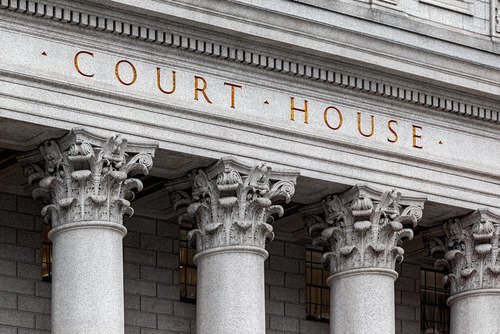Multidistrict litigation (MDL) is the process of streamlining complex civil lawsuits that arise out of the same course of conduct – like mass tort cases and products liability claims – by consolidating them into a single federal district court for pretrial proceedings.
In this article, our personal injury lawyers describe the multidistrict litigation process and its goals before explaining how it can impact your case.
- 1. Cases that are eligible for multidistrict litigation (MDL)
- 2. Problems that multidistrict litigation aims to solve
- 3. How multidistrict litigation works
- 4. Examples of multidistrict litigation in action
- 5. Differences between multidistrict litigation and class actions
- 6. How MDLs can impact your case
- 7. A personal injury attorney can help

Multidistrict litigation (MDL) is the process of streamlining complex civil lawsuits by consolidating them
1. Cases that are eligible for multidistrict litigation (MDL)
Multidistrict litigation, or MDL, is only an option for civil cases that are brought in federal court.
Civil cases are contrasted with criminal cases. Civil cases are those filed by an injured party, also known as the plaintiff, against the person or company who hurt them, or the defendant. Civil cases seek compensatory damages for the losses that the plaintiff has suffered.
These cases can be filed in federal court, rather than in state court, if either:
- The plaintiff and the defendant are from different states and the damages at issue total more than $75,000,1 or
- The case implicates federal law.2
When a civil case that is filed in federal court shares many of the same facts with other civil cases in other federal courts, it can be wise to combine them together in multidistrict litigation. Some types of civil cases that frequently get consolidated into MDL include mass tort cases, such as:
- A plane crash with hundreds of victims,
- A products liability scenario, where a defective product has been sold to thousands of people and is now hurting them,
- Defective drug cases, where a drug was defectively designed, manufactured, or advertised.
2. Problems that multidistrict litigation aims to solve
When one act by a defendant could be responsible for the injuries of hundreds of people from a variety of different places, allowing each victim to pursue their own claim would raise a litany of problems:
- The court system would have to hear hundreds of very similar cases individually, further straining the judicial system’s already limited time and resources,
- Each plaintiff would be hiring their own lawyer, ballooning the legal costs of filing the lawsuits and reducing the compensation that each plaintiff stood to receive,
- The defendant would have to hire lawyers in all of the different courts hearing a case,
- Identical pieces of physical evidence would be needed in each court hearing a claim,
- Testimony would have to be delivered in each court, requiring critical witnesses to not only visit every locale for deposition and trial, but also repeat their testimony verbatim or risk harming their credibility with conflicting statements or even committing perjury,
- There is the potential for judges and juries hearing nearly identical claims to come to contradictory judgments.
In order to avoid these problems, Congress passed a law that lets courts consolidate these claims in multidistrict litigation.3

Through the MDL process, eligible cases are transferred to one federal district court for all of the pretrial proceedings.
3. How multidistrict litigation works
Through the MDL process, personal injury cases that involve lots of similar facts, but that happened to people in a variety of places across the country, are transferred to one federal district court for all of the pretrial proceedings. These pretrial proceedings include:
- Gathering evidence during the discovery process,
- Motions to dismiss the case,
- Motions for summary judgment,
- Evidentiary challenges,
- Depositions and interrogatories,
- Settlement offers.
If the case does not settle during these pretrial proceedings, it is then transferred back to the district court from which it originated for the trial.
If new claims are filed by new victims that involve the same or similar fact patterns as a case already in multidistrict litigation, those new claims can be transferred and included in the MDL. These are referred to as tag-along cases.
4. Examples of multidistrict litigation in action
One of the most prominent examples of multidistrict litigation in action is taking place in the Eastern District of Pennsylvania, and involves personal injuries caused by asbestos products.4 It was started in 1991 and has handled 192,101 personal injury claims as of March 15, 2019.5
While it is the most prominent MDL, the asbestos litigation is an outlier. Most involve only a few dozen to a few hundred plaintiffs and claims. Some of the more typical personal injury and products liability claims in MDL include:
- An MDL in the Eastern District of Pennsylvania filed by football players against the NFL for the effects of mild traumatic brain injuries caused by on-field contact,6
- An MDL in the Northern District of Florida concerning the side effects of the anti-psychotic medication Abilify,7 and
- An MDL in the District of Massachusetts concerning potential defects in a metal prosthetic used for hip replacements.8
In each of these cases, victims from numerous states have suffered the same types of injuries and experienced the same types of losses from the same kinds of conduct.
5. Differences between multidistrict litigation and class actions
While MDLs sound a lot like class actions, there are important differences between the two. Most importantly:
- Class actions consolidate all claims and plaintiffs into one lawsuit, while MDLs merely move all lawsuits into one court,
- Class actions combine cases for the entire court process, while MDLs only combine the cases for the pretrial portion before transferring the case back to the originating federal court for the trial, and
- MDLs do not require plaintiffs to certify their class, unlike for class actions.
6. How MDLs can impact your case
Pursuing a personal injury claim through multidistrict litigation will change how your case proceeds in several important ways. Not all of them, however, will impact the outcome of your case or your ability to recover the compensation you deserve.
The main difference that comes from MDL is the feeling of alienation. Your case will be heard hundreds or thousands of miles away, which can leave you feeling isolated from the process. However, this can also reduce the amount of time you will personally have to spend on it by, for example, preparing for and being interviewed in a deposition.
There are, however, some differences between a regular personal injury case and an MDL that can impact the outcome. Some of these bode well for plaintiffs, while others help defendants. For example:
- By working like a team and sharing information, lawyers working for the plaintiffs reduce their aggregate legal costs. This means more of the compensation award will get to the victims,
- Because they only have to defend themselves in one place, the defendant’s legal costs are also reduced. This often allows them to raise a wider variety of legal defenses, including those that are designed to prolong the case,
- With so many plaintiffs from so many states, there will be complicated questions about which state’s law will apply to your claim, which can help or hurt a lot,
- Most MDLs are hosted by a federal district court in the defendant’s state in order to minimize the inconvenience for everyone involved. While this is not supposed to impact the outcome, the reality is that the court can feel pressure to protect local companies, and
- Consolidating claims into an MDL creates publicity that can lead to more victims filing claims. This raises the stakes for defendants, so they often vigorously defend against the first wave of claims in the MDL.
Another big difference in multidistrict litigation is that they are often even more likely to settle than a normal personal injury claim. This is especially true if your case is a tag-along claim, rather than one of the first lawsuits in the MDL. These initial claims in an MDL often lead to bellwether trials. The success or failure of these bellwether trials will influence the remaining cases in the MDL. Successful bellweather trials will push defendants to settle subsequent cases, even at higher amounts. Unsuccessful bellwether trials can drastically reduce the settlements offered to later cases in the MDL.
7. A personal injury attorney can help

Contact us for advice and representation.
Multidistrict litigation is far more complex than most personal injury lawsuits. The personal injury attorneys at the Shouse Law Office can help navigate the complicated and often confusing legal path towards recovery. Contact us online or call our law office for help.
Legal References:
- 28 U.S.C. § 1332
- 28 U.S.C. § 1331
- 28 U.S.C. § 1407
- MDL 875, In Re: Asbestos Products Liability Litigation (No. VI).
- MDL Statistics Report – Distribution of Pending MDL Dockets by District.
- MDL 2323, In Re: National Football League Players’ Concussion Injury Litigation.
- MDL 2734, In Re: Abilify (Aripiprazole) Products Liability Litigation.
- MDL 2768, In Re: Stryker LFIT V40 Femoral head Products Liability Litigation.
